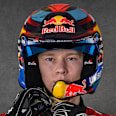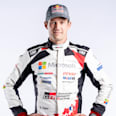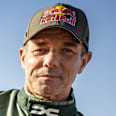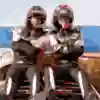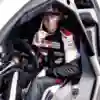
WRC
The 22-year-old's arrival at the top of the World Rally Championship has demonstrated a new approach to the game from rallying's next generation.
It might seem a touch odd, awkward even, to compare the sedate, graceful art of spin bowling a cricket ball with forcing a 500bhp rally car between the trees at speeds some way north of 150kph.
But it’s a comparison which works... or worked.
Here’s the thinking. Bowlers like Sri Lanka's exceptional right-arm leg-breaker Muttiah Muralitharan or Australia’s late great Shane Warne were the undoubted masters of their craft in the same way Tommi Mäkinen, Juha Kankkunen or Sébastien Loeb and Sébastien Ogier were in world rallying.
Across both sports, that excellence was built on experience.
For Muralitharan that meant over after over after over at London's Oval or Newlands in Cape Town. He would watch the pitch develop, understand the cloud cover, the humidity and what a change in wind direction could and would do.
Down the years, that information was stored. Logged. You could talk about it, but you couldn't teach it. You had to learn it and earn it. That feel for the conditions and an understanding of what it would do to the ball. It became an almost subconscious thing. It's for that reason that Muralitharan was the world's number one test bowler for a record-breaking 1,711 days.
It's for a similar reason that the likes of Mäkinen, Kankkunen and the French superheroes of rallying could dominate for so long. Experience.
Rallies are run once a year. They come, they go. The crews are allowed to drive the stages at a limited speed of 80kph twice by way of a recce. After that, they get one or two chances (depending if a road is used once or twice on the route) to go flat out through those corners.
Make a mistake, crash and you're not coming back for another 12 months. Along with your hopes of a result on that rally, your mistake has hit you in the longer-term search for experience too.
When Formula 1 race winner Robert Kubica switched to rallying full time in 2013, it was one of the aspects of the sport he struggled most with.
"It's so hard,” he said. “In circuit racing, if you make a mistake, then you can come back and drive this circuit again. You can make some more experience. If this happens in rallying, if you go off the road, you don't see the place again for another year. And when you come back, the condition of the road and the corner can change completely. So much of rallying is still about the experience you can build through the career."
The season-opening Rallye Monte-Carlo was a classic case in point. The French Alps in January have many different faces. They have the benign, warm, sunny smiley one, which makes for great grip and fast roads. Or they have the dark, chilling, ice-laden, version that demands an understanding of how conditions will evolve and which tyre will work and when.
Colin McRae hated the Monte.
"It's just never the same," he said after sliding off the road on the 1995 event. "You don't know where you'll have black ice or clean tarmac. And then you have the spectators throwing the snow on the road – you don't know where they’re going to be. You need so much experience on this rally."
And you could only get that experience once a season.
Admittedly, you could drive most of the roads in the WRC whenever you want. The famous Col de Turini is, for example, a public road that can be consumed by anybody, anytime. But bolting a set of soft slicks to your rally car and ripping it up at full speed on a cloudy March morning is not an option.
It's for that reason that World Rally Champions have always tended to be crowned later in their careers. For close to three decades, a 27-year-old McRae was rallying's youngest world champion.
Until now.
In New Zealand earlier this month, Kalle Rovanperä beat McRae’s record by five years and 88 days. That’s a big margin.
How did he shortcut the experience?
Firstly, it's vital to remember that Rovanperä has bags of experience behind the wheel. Much is made of the fact that he was driving a rally car from the age of eight on test roads (he was driving more mundane cars before that), but it's the fact that he was competing in a tier-two (R5 or Rally2 as they’re now known) car from the age of 15 that really helped.
And, how many 16-year-olds do you know who tested Toyota's Yaris WRC in the 2016 season?
Rovanperä's wheel time was pretty much second-to-none coming into the sport, but that’s only half the battle. What about the changing conditions, the way Monte’s stages vary from season to season?
Technology has helped no end in that direction. At the start of the 2018 season, WRC Promoter revolutionised the sport for fans. And competitors.
All Live is an astonishing streaming service that brings live footage from every corner of every stage of every rally from right around the world.
Fans get to see – and hear – everything. It’s amazing. And it’s changed everything. There are no secrets anymore.
Mid-way through 2018, Sébastien Ogier wasn't so sure. "Of course, All Live is good for the fans," said the eight-time champion. "But for me, I'm not so sure. Now, with all of the onboards and all of the cameras, it's difficult to keep things for yourself. Now, everybody can see where the drivers are braking, how they're using their notes and what they are doing in the stages all of the time.
"We used to make the experience for a long time, but now the new guys coming to the sport can watch and keep watching every stage."

Granted, there's nothing like driving the roads for yourself, but being able to watch how the road evolves between a morning and afternoon pass is invaluable. Youngsters have the opportunity to overlay tyre data and a speed matrix across that to give an even more well-rounded picture of what to expect.
"Definitely, it's helping," said Rovanperä, ahead of his WRC debut in the sport's top class at the top of the 2020 season. "It's interesting to see how the line changes and to see where the guys are cutting, things like that."
Such universal access has changed more than just the chances of young drivers.
"I remember when I started in the sport," said Dani Sordo. "You would come to the recce and maybe there would be one night when you could go get dinner and just see some of the guys in a friendly way. Now? Not at all. Now everybody is onboards, onboards and videos all the time. The sport is changing a lot now."

